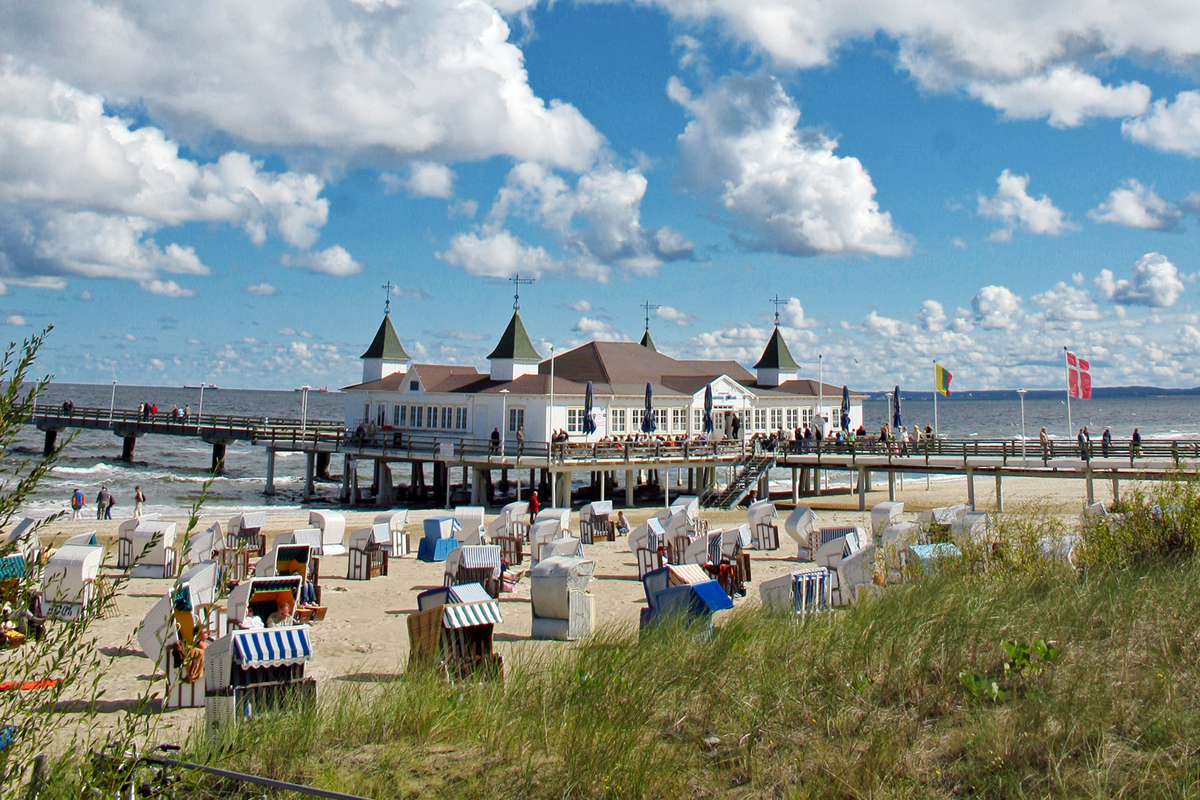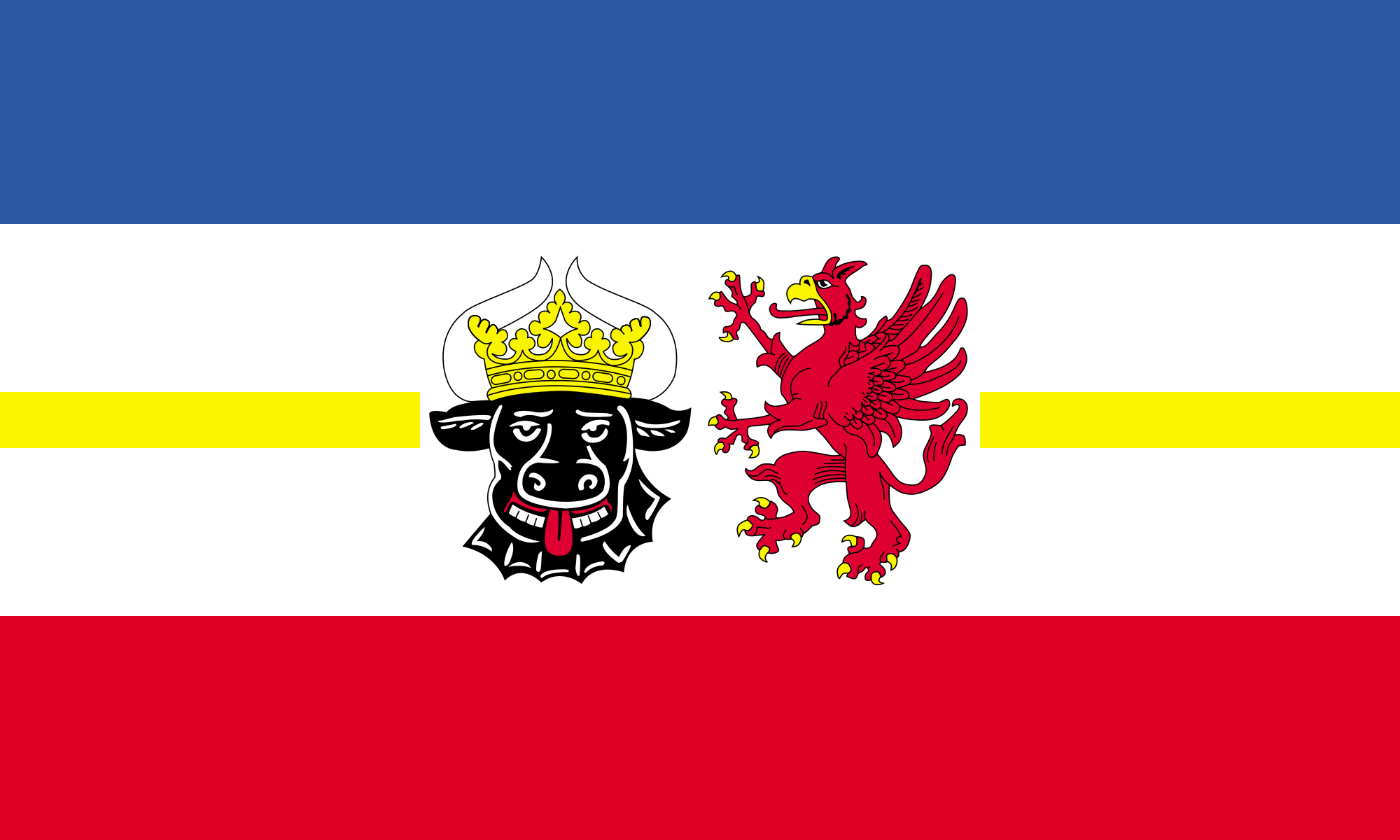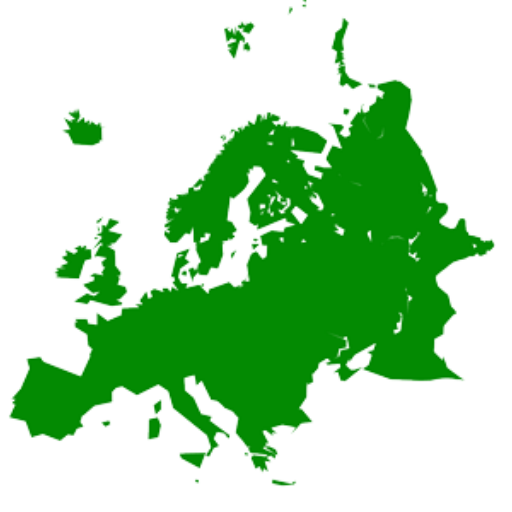
Deutsch-Chinesische Enzyklopädie, 德汉百科
 Poland
Poland

 Colleges and Universities in Europe
Colleges and Universities in Europe
 Nobel prize
Nobel prize
 Nobel Prize in Literature
Nobel Prize in Literature
 Nobel prize
Nobel prize
 Nobel Peace Prize
Nobel Peace Prize
 Nobel prize
Nobel prize
 Nobel Memorial Prize in Economic Sciences
Nobel Memorial Prize in Economic Sciences
 Nobel prize
Nobel prize
 University/Institute
University/Institute




波罗的海上的乌泽多姆岛有广阔的沙滩,这里每年的日照时间近2000小时。从19世纪末开始,这里不仅吸引了大量的游客,还有皇室成员前来休养度假。如 今,乌泽多姆海滨矿泉浴场上,典雅的古代建筑现已成为高档酒店及设施先进的旅馆。尤其是班辛(Bansin), (Heringsdorf)和 (Ahlbeck)这三个皇家浴场上的辉煌建筑,以及带有精美小塔、典雅立柱和高大山墙的别墅立面,都一如既往地光芒四射。1899年建成的阿尔贝克跨海 大桥,是整个乌泽多姆岛的标志性建筑。而长达508米的黑灵斯多夫跨海大桥,则是欧洲大陆这一类型中最长的建筑。依托于这一历史古迹,人们在周围地区建造 了一条购物街、一家艺术馆、几家咖啡馆、博物馆和餐馆。(Quelle:http://www.germany-tourism.cn)


波兰现在分成16个一级行政区,称为“województwa”(单数为województwo),中文翻译为“省”。
| 省份 | 首府城市 | 面积(km²) | 人口(2017年)[1] |
|---|---|---|---|
| 马佐夫舍省 (Mazowieckie) |
华沙 (Warszawa) |
35,579 | 5,391,813 |
| 小波兰省 (Małopolskie) |
克拉科夫 (Kraków) |
15,108 | 3,395,700 |
| 罗兹省 (Łódzkie) |
罗兹 (Łódź) |
18,219 | 2,470,610 |
| 卢布林省 (Lubelskie) |
卢布林 (Lublin) |
25,155 | 2,121,600 |
| 波德拉谢省 (Podlaskie) |
比亚韦斯托克 (Białystok) |
20,180 | 1,182,700 |
| 喀尔巴阡山省 (Podkarpackie) |
热舒夫 (Rzeszów) |
17,844 | 2,128,747 |
| 圣十字省 (Świętokrzyskie) |
凯尔采 (Kielce) |
11,672 | 1,244,400 |
| 大波兰省 (Wielkopolskie) |
波兹南 (Poznań) |
29,826 | 3,490,597 |
| 瓦尔米亚-马祖里省 (Warmińsko-Mazurskie) |
奥尔什丁 (Olsztyn) |
24,192 | 1,431,100 |
| 卢布斯卡省 (Lubuskie) |
大波兰地区戈茹夫 (行政) (Gorzów-Wielkopolski) 和绿山城(立法) (Zielona-Góra) |
13,985 | 1,015,440 |
| 滨海省 (Pomorskie) |
格但斯克 (Gdańsk) |
18,293 | 2,328,200 |
| 西滨海省 (Zachodniopomorskie) |
什切青 (Szczecin) |
22,896 | 1,703,000 |
| 库亚维-滨海省 (Kujawsko-Pomorskie) |
比得哥什(行政) (Bydgoszcz) 和托伦(立法) (Toruń) |
17,969 | 2,079,900 |
| 西里西亚省 (Śląskie) |
卡托维兹 (Katowice) |
12,294 | 4,540,100 |
| 奥波莱省 (Opolskie) |
奥波莱 (Opole) |
9,412 | 988,031 |
| 下西里西亚省 (Dolnośląskie) |
弗罗茨瓦夫 (Wrocław) |
19,946 | 2,901,000 |



华沙(波兰语:Warszawa [varˈʂava] ![]() 试听)是波兰首都及最大城市,位于维斯拉河两岸,距波罗的海和喀尔巴阡山脉大约350公里。2008年人口数字为1,707,983人,都市圈人口大约2,785,000人。城市面积512平方公里,都市圈面积12266平方公里。冷战时期著名的华沙公约就是于此签署的。
试听)是波兰首都及最大城市,位于维斯拉河两岸,距波罗的海和喀尔巴阡山脉大约350公里。2008年人口数字为1,707,983人,都市圈人口大约2,785,000人。城市面积512平方公里,都市圈面积12266平方公里。冷战时期著名的华沙公约就是于此签署的。
该市也是马佐夫舍省的省会,拥有许多工业企业(制造、钢铁、电气工程、自动工业),66所高等学府(包括华沙大学),和超过30家剧院。
第二次世界大战时期的1944年8月,十八世纪的历史名城-华沙,在纳粹德国占领军的空袭下,百分之八十五的历史建筑遭到毁灭。二战之后,华沙人民用长达五年的时间重建家园,他们修建了教堂、宫殿和贸易场所。华沙的重生是十三至二十世纪建筑史上的不可抹灭的一笔。
波兰的首都华沙建立于公元13世纪,位于欧洲北部平原心脏地带,地势为维斯图拉河岸边水土丰饶的斜坡地,沿克拉科夫下游的城市横跨维斯图拉河两岸。历史上一直是政治、行政中心,现为国家首都和主要省会城市。
1280年马佐瓦亚公爵建立华沙,修建城堡以控制维斯图拉河渡口,这是华沙城开始发展的标志。1344年华沙成为马佐瓦亚公国首都。15世纪,历任公 爵在华沙修建了自己的住宅,随着城市功能的迅速完善,华沙的政治地位也越发显赫。1596年,波兰王城从克拉科夫迁移至华沙古城,从此华沙成为波兰的政治 文化中心。城市大兴土木,华沙即刻兴盛起来。1656和1702年华沙两次被瑞典人摧毁,又两度重建。18世纪末华沙成为欧洲最大的城市。
二次大战末期,华沙举行反纳粹占领者起义,起义总指挥部设在古城。起义失败后,希特勒下令把华沙从地球上抹掉。古城90%被毁。战后,人们急切地展开了重建工作。到1966年,所有旧城的纪念建筑都依照14至18世纪原样重新修建。
华沙文化中心靠近维斯图拉河岸,城市围绕着集市广场发展起来,主要特点是街道按照方格网状进行布局规划。随着街道从市中心向外延伸,这种布局的规范性逐渐消失。宽阔的广场提供了广大深远的视野。
16-18世纪的建筑物外墙为华沙提供了一种赏心悦目的景色,装饰着壁画和石门的房屋沿市场一直延展开去。广场附近另一排房屋正面建造了装饰性的拱顶 和游廊。老城边上靠近城堡的地方,一连片色彩艳丽的住房与整个城市和谐地融为一体。俯瞰全城的皇宫旁另有一些纪念建筑成为重建后华沙的点缀,这些建筑具有 哥特式、文艺复兴式和巴洛克等各种风格。靠近城堡并沿维斯图拉河生长的绿林将老城环绕起来。
(Quelle: www.guwh.com)
Warschau (polnisch Warszawa [varˈʃava] ) ist seit 1596 die Hauptstadt Polens[2] und die flächenmäßig größte sowie mit über 1,7 Mio. Einwohnern bevölkerungsreichste[3] Stadt des Landes. Als eines der wichtigsten Verkehrs-, Wirtschafts- und Handelszentren Mittel- und Osteuropas genießt Warschau große politische und kulturelle Bedeutung. In der Stadt befinden sich zahlreiche Institutionen, Universitäten, Theater, Museen und Baudenkmäler.
Beidseitig am Strom der Weichsel (pln. Wisła) in der Woiwodschaft Masowien gelegen, stellt sie das Zentrum der zweitgrößten Agglomeration Polens mit rund 3,5 Mio. Einwohnern dar. Ihr Stadtgebiet gliedert sich in 18 Stadtbezirke, unter denen Śródmieście (Stadtmitte) die Innenstadt ausmacht und das UNESCO-Welterbe der wiederaufgebauten Warschauer Altstadt beherbergt.
ワルシャワ(Warszawa![]() [varˈʂava];ヴァルシャヴァ、英: Warsaw、ワルソー[ˈwɔːrsɔː])は、ポーランドの首都でかつ同国最大の都市。マゾフシェ県の県都。ポーランドの政治、経済、交通の要衝でもある。
[varˈʂava];ヴァルシャヴァ、英: Warsaw、ワルソー[ˈwɔːrsɔː])は、ポーランドの首都でかつ同国最大の都市。マゾフシェ県の県都。ポーランドの政治、経済、交通の要衝でもある。
ワルシャワにはヴィスワ川の中流、マゾフシェ地方に位置し、市内をヴィスワ川が貫通する。第2次世界大戦後、戦火で荒廃した旧市街を「煉瓦のヒビに至るまで」復元して往時の町並みを回復した。1980年、ユネスコに「ワルシャワ歴史地区」として世界遺産に登録された。
製造業、鉄鋼業、電機産業、自動車産業などの工業都市であり、ワルシャワ大学を初めとするポーランド有数の高等教育機関が集中し、歌劇場やワルシャワ国立フィルハーモニー管弦楽団を擁する首都。
毎年8月1日の午後5時、サイレンの音を合図にワルシャワ市内では人によりその場で直立不動となり1分間の黙祷を捧げるとされる。この1分間は全ワルシャワ市の部分的な機能が停止するとも云われる。これは1944年8月1日午後5時に開始されたワルシャワ蜂起での犠牲者を追悼する行事。この時刻およびその行事は、ワルシャワ(Warszawa)の頭文字をとって「時刻W」と呼ばれる。
Warsaw (Polish: Warszawa [varˈʂava] (![]() listen); see also other names) is the capital and largest city of Poland. The metropolis stands on the Vistula River in east-central Poland and its population is officially estimated at 1.765 million residents within a greater metropolitan area of 3.101 million residents,[4] which makes Warsaw the 8th most-populous capital city in the European Union. The city limits cover 516.9 square kilometres (199.6 sq mi), while the metropolitan area covers 6,100.43 square kilometres (2,355.39 sq mi).[5] Warsaw is an alpha global city, a major international tourist destination, and a significant cultural, political and economic hub.[6][7] With a GDP PPP of $230 billion and $43,200 per capita, it is one of the wealthiest capital cities in Central and Eastern Europe.[8] Moreover, its historical Old Town was designated a UNESCO World Heritage Site.
listen); see also other names) is the capital and largest city of Poland. The metropolis stands on the Vistula River in east-central Poland and its population is officially estimated at 1.765 million residents within a greater metropolitan area of 3.101 million residents,[4] which makes Warsaw the 8th most-populous capital city in the European Union. The city limits cover 516.9 square kilometres (199.6 sq mi), while the metropolitan area covers 6,100.43 square kilometres (2,355.39 sq mi).[5] Warsaw is an alpha global city, a major international tourist destination, and a significant cultural, political and economic hub.[6][7] With a GDP PPP of $230 billion and $43,200 per capita, it is one of the wealthiest capital cities in Central and Eastern Europe.[8] Moreover, its historical Old Town was designated a UNESCO World Heritage Site.
Once described as the Paris of the East, Warsaw was believed to be one of the most beautiful cities in the world until World War II.[9] Bombed at the start of the German invasion in 1939, the city withstood a siege for which it was later awarded Poland's highest military decoration for heroism, the Virtuti Militari.[10][11][12] Deportations of the Jewish population to concentration camps led to the Warsaw Ghetto Uprising in 1943 and the destruction of the Ghetto after a month of combat. A general Warsaw Uprising between August and October 1944 led to even greater devastation and systematic razing by the Germans in advance of the Vistula–Oder Offensive. Warsaw gained the new title of Phoenix City because of its extensive history and complete reconstruction after World War II, which had left over 85% of its buildings in ruins.[13][14]
Warsaw is one of Europe's most dynamic metropolitan cities.[15] In 2012 the Economist Intelligence Unit ranked Warsaw as the 32nd most liveable city in the world.[16] In 2017 the city came 4th in the "Business-friendly" category and 8th in "Human capital and life style".[15] It was also ranked as one of the most liveable cities in Central and Eastern Europe.
The city is a significant centre of research and development, Business process outsourcing, Information technology outsourcing, as well as of the Polish media industry. The Warsaw Stock Exchange is the largest and most important in Central and Eastern Europe.[17][18] Frontex, the European Union agency for external border security as well as ODIHR, one of the principal institutions of the Organization for Security and Cooperation in Europe have their headquarters in Warsaw. Together with Frankfurt, London and Paris, Warsaw is also one of the cities with the highest number of skyscrapers in the European Union.[19]
The city is the seat of the Polish Academy of Sciences, Warsaw National Philharmonic Orchestra, University of Warsaw, the Warsaw Polytechnic, the National Museum, the Great Theatre—National Opera, the largest of its kind in the world,[20] and the Zachęta National Gallery of Art. The picturesque Old Town of Warsaw, which represents examples of nearly every European architectural style and historical period,[21] was listed as a World Heritage Site by UNESCO in 1980. Other main architectural attractions include the Castle Square with the Royal Castle and the iconic King Sigismund's Column, the Wilanów Palace, the Łazienki Palace, St. John's Cathedral, Main Market Square, palaces, churches and mansions all displaying a richness of colour and detail. Warsaw is renowned for its bars, restaurants, art galleries and, most notably, several dozen museums and outspread greenery,[22] with around a quarter of the city's area occupied by parks.[23]
Varsovie (prononcé [vaʁ.sɔ.vi] ; en polonais : Warszawa [var.ˈʃa.va] Écouter) est depuis 1596 la capitale de la Pologne et depuis 1999 le chef-lieu de la voïvodie de Mazovie. Elle est située sur la Vistule, à environ 320 km de la mer Baltique et des Carpates. Peuplée par plus d'1,8 million d'habitants (3 millions pour l'agglomération), la capitale polonaise est aussi la plus grande ville du pays et la 8e plus grande de l'Union européenne. Varsovie se divise en dix-huit arrondissements (dzielnice).
Connue comme la Ville-phénix pour avoir réussi à renaître de ses cendres (84 % de ses bâtiments ont été détruits durant la Seconde Guerre mondiale2,3), Varsovie a connu une croissance spectaculaire au cours de la seconde moitié du XXe siècle et cette croissance a encore été ravivée après le passage de la Pologne à l’économie de marché dans les années 1990. L’agglomération continue à se transformer et à se développer à un rythme soutenu : elle regroupe toute une gamme d'industries et soixante-six établissements d'enseignement supérieur. C’est aussi un centre artistique et culturel important, une place financière et un pôle économique majeur en Europe centrale.
Varsovie a donné son nom à la Confédération de Varsovie, au Pacte de Varsovie, au Duché de Varsovie, à la Convention de Varsovie, aux différents Traités de Varsovie et à l'Insurrection de Varsovie. La Varsovienne de 1831 est largement considérée comme l'hymne officieux de Varsovie4.
Varsovie dispute à Budapest le rang de 9e plus grande ville de l'Union européenne.
Varsavia (AFI: /varˈsavja/[1]; in polacco , [varˈʂava]) è la capitale della Polonia, e la più grande città del Paese, situata nella parte centro-orientale della Polonia nel voivodato della Masovia, sul fiume Vistola. Varsavia è il principale centro scientifico, culturale, politico ed economico della Polonia. Varsavia è anche il capoluogo del voivodato della Masovia, e costituisce al contempo comune e distretto.
Varsavia è la più grande città polacca in termini di popolazione (1.726.581 residenti registrati nel 2014[2]) con una estensione superficiale di 517,24 km² (compresa la Vistola), si classifica al decimo posto delle città più popolose dell'Unione europea (escludendo la sua area metropolitana di circa 3.101.000 abitanti).
Varsovia (en polaco: Warszawa, en Alfabeto Fonético Internacional: ![]() [varˈʂava] (?·i), en inglés: Warsaw) es la ciudad más grande de Polonia, y la capital del país desde el año 1596, cuando el rey Segismundo III Vasa la trasladó desde Cracovia. Varsovia es también la sede del presidente de la República, del Parlamento y del resto de las autoridades centrales. Cuenta con una población de 1 745 000 habitantes2 (en 2014), lo que la convierte en la novena ciudad más poblada de la Unión Europea, y que posee unos 3 101 000 habitantes en su área metropolitana.
[varˈʂava] (?·i), en inglés: Warsaw) es la ciudad más grande de Polonia, y la capital del país desde el año 1596, cuando el rey Segismundo III Vasa la trasladó desde Cracovia. Varsovia es también la sede del presidente de la República, del Parlamento y del resto de las autoridades centrales. Cuenta con una población de 1 745 000 habitantes2 (en 2014), lo que la convierte en la novena ciudad más poblada de la Unión Europea, y que posee unos 3 101 000 habitantes en su área metropolitana.
Varsovia es conocida internacionalmente por haber dado su nombre al Pacto de Varsovia, a la Convención de Varsovia, al Tratado de Varsovia y al Alzamiento de Varsovia.
El centro histórico de la ciudad, completamente destruido a raíz del Alzamiento de Varsovia en 1944, fue reconstruido meticulosamente después de la guerra, y en 1980 fue declarado Patrimonio de la Humanidad por la Unesco como "ejemplo destacado de reconstrucción casi total de una secuencia histórica que se extiende desde el siglo XIII hasta el siglo XX".3
Es uno de los principales centros económico-financieros y culturales de Europa Central.
Варша́ва (польск. Warszawa, МФА: [varˈʂava] ![]() слушать) — столица и крупнейший по населению и по территории город в Польше.
слушать) — столица и крупнейший по населению и по территории город в Польше.
Город стал фактической столицей в 1596 году, когда после пожара в Вавельском замке в Кракове король Сигизмунд III перенёс свою резиденцию сюда, при этом столичный статус города был подтверждён только в Конституции 1791 года. Через город протекает река Висла.
Впервые название появляется в рукописях XIV века в виде Warseuiensis (1321) и Varschewia (1342), а в XV веке как Warschouia (1482).
Большинство историков и лингвистов считает, что название города произошло от притяжательного прилагательного Warszewa (или Warszowa) от имени Warsz (популярного в средневековье сокращения имени Warcisław, Wrocisław).
Смена названия с Warszewa на Warszawa произошло в XVI веке, и связано это было с особенностями мазовецкого диалекта, на территории распространения которого расположена Варшава. В этом диалекте до конца XV века гласный a переходил в e после мягких согласных (а sz в польском языке на тот момент был мягким). В XV веке формы с вторичным e считались диалектными, поэтому люди, старавшиеся говорить на литературном языке, заменяли их формами с a. В случае с Варшавой же произошла замена этимологически правильной формы на гиперкорректную.
В народе же распространено мнение, что название Warszawa появилось в результате соединения имени рыбака по имени Wars и русалки, прозванной Sawa, на которой рыбак женился. Образ Русалки Савы стал символом Варшавы[3].
Существует легенда об основании Варшавы: некий князь (властелин) по имени Казимир, заблудившись на охоте, набрёл на бедную рыбацкую хижину на берегу Вислы. Там он обнаружил молодую рыбачку, только родившую близнецов с именами Варш и Сава. Казимир стал их крёстным отцом и наградил семью рыбака за гостеприимство. Рыбак на эти деньги построил дом, вокруг которого стали селиться другие рыбаки, что положило начало Варшаве[4].



 Agriculture, forestry, livestock, fishing
Agriculture, forestry, livestock, fishing


 Automobile
Automobile
 Companies
Companies
 Geography
Geography
 Mecklenburg-Vorpommern
Mecklenburg-Vorpommern
 Vacation and Travel
Vacation and Travel
 Architecture
Architecture
 Religion
Religion
 European Union
European Union
 States of Europe
States of Europe
 Music
Music
 Performing Arts
Performing Arts
 International cities
International cities
 History
History
 World Heritage
World Heritage



 Christmas Market
Christmas Market